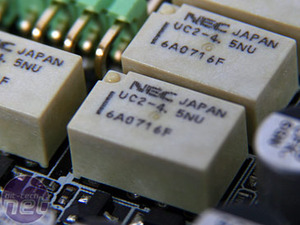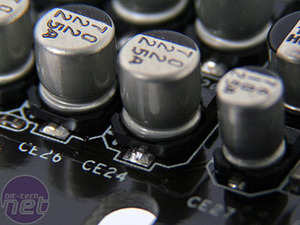
Power
Like the D2 and D2X, the Xonar DX still requires a power connector and while we never got an answer as to why this was the case when we first did our D2X review, we have since had chance to sit down with a couple of engineers working on the Xonar project.When asked, they explained that this is purely because the power from a PSU is far cleaner than it is from the motherboard, meaning you again get far less interference and therefore better quality sound. At least, that’s how the theory works.
Sure, it’s a pain in the back side, especially since it’s a floppy connector and not a Molex, but we have more respect for it now that we know its presence is actually for our benefit.
The connector setup is also better than the XtremeGamer – Asus uses a standard four stereo 3.5mm audio jacks for the 7.1 surround sound, and the fifth jack doubles as optical S/PDIF out and microphone/line in.
This should work with any set of speakers you buy. In contrast, if you want to use a 7.1 surround setup with the Creative card you have to find a compatible set of speakers that use four-pole 3.5mm plugs, not the usual three pole which is at best, a ball ache.
Missing from the Xonar DX are the LED backlit sockets – so instead of being able to easily tell which plug needs to go where you’re left in the dark because while the sockets are labelled, they aren’t colour coded like they are on the XtremeGamer. It's simply a style over ease of use issue, that's all – you can't win with both here. If we weren’t such cool, cutting edge fashion gurus we’d probably not even care that the Asus Xonar DX even looks better – its gunmetal PCI bracket and gold plated audio connectors fit perfectly with the brown PCB.
Shoehorning in EAX 5.0
Before now, EAX 2.0 was the only Creative EAX that could be used by other companies but this is an old technology though, limiting the user to just 32 simultaneous 3D voices. All the EAX Advanced HD versions from 3.0 to 5.0 had been limited to Creative hardware itself from the Audigy onwards – in comparison, version 5.0 supports up to 128 simultaneous 3D voices and the “Advanced HD” aspect also means it allows for higher frequencies and sampling rates.What Asus has done is reverse engineer its new DS3D GX 2.0 engine to emulate EAX 5.0 support (which is merely an extension of 3.0 and 4.0). The Xonar now supports the same 128 voices and HD frequencies and sampling rates to match the Creative, although the processing is done through software on the host CPU not the card itself. When the X-Fi launched in 2005, multi-core CPUs were few and far between, so offloading sound processing from the single CPU core was a good idea at the time, however we’re now in a time where dual and quad-cores are the norm.
At the same time, games are still largely single threaded or marginally threaded, allowing some spare overhead to be used for audio processing. Even then, audio processing has never really been that intensive – how often do you find someone suggests changing their soundcard or turns down the sound settings in game because it runs too slow?
DS3D GX 2.0 flags the card as EAX 5.0 compliant in the game or software, and then basically emulates the effect between hardware and software. We contacted Asus and a representative explained:
“Our implementation is not a 1:1 reproduction of EAX 5.0. Rather, DS3D GX 2.0 allows users the choice to universally access gaming audio effects that would otherwise be locked behind specific cards and patched game titles. While we do respect the capability of a dedicated DSP processor [such as Creative’s X-Fi] to offload the CPU work, we believe performance differences will continue to diminish based on the power of today's popular CPUs. We also expect more game developers to adopt software DSP effects [Dolby Digital and DTS] for their flexibility and universally guaranteed user experiences.”
The “software effects” argument is what we heard from Asus at CeBIT in 2007 before it launched the Xonar D2. It is confident that, as the popularity of consoles increases and the cost of games development increases (and as a result cross-platform development becomes more common), more games will predominantly support Dolby Digital (and DTS) over Creative’s proprietary EAX technology.
While the Asus Xonar DS3D GX 2.0 is supported under both XP and Vista, because of the way Vista works in OpenAL, it works very similarly to Creative’s Alchemy. However the difference is that the DS3D GX 2.0 engine is agnostic and driver integrated, whereas Alchemy is a separate program that requires specific configurations for each game.

MSI MPG Velox 100R Chassis Review
October 14 2021 | 15:04










Want to comment? Please log in.